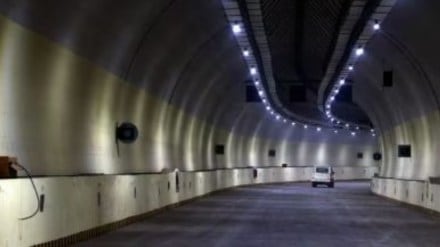Mumbaikars are in for a smoother and faster journey when traveling from Marine Drive to Breach Candy. A report published by The Indian Express revealed that it took their team three minutes and twenty seconds to travel the distance through a soon-to-be-launched 2.07-kilometres twin tunnel in Mumbai.
When will the tunnels be inaugurated?
The toll-free twin tunnels are set to be inaugurated in the second week of February, The Indian Express reported. The tunnels will cut down the time taken to travel from Marine Drive to Breach Candy by over 26 minutes. Usually, vehicles take 30 minutes to cover the distance via a 6-kilometre stretch on the surface. On the same route, motorists require to cross seven traffic signals.
The tunnels start near Girgaon, extending further under the Arabian Sea, Girgaon Chowpatty and Malabar Hill, and end at Breach Candy’s Priyadarshini Park.
They have been built as a part of the 10.58-kilometres high-speed Mumbai Coastal Road Project (MCRP). The project is being completed by the Brihanmumbai Municipal Corporation (BMC) at a cost of Rs 12,721-crore.
Mumbai Coastal Road Project
A major infrastructure boost for Mumbai, the MCRP will be connecting Marine Drive to the Bandra-Worli Sea Link. The objective of the project is to reduce the travel time from nearly one hour during peak hours to just under 10 minutes.
The Indian Express report said that the civic officials have informed that initially, the MCRP will be operational only between 8 am and 8 pm on weekdays.
The broader MCRP project envisions connecting Marine Drive with suburban Dahisar through a toll-free freeway, providing uninterrupted connectivity to the Maximum City’s western coast.
Earlier, Maharashtra Chief Minister Eknath Shidne said that the construction work for the MCRP will be over by January 31, adding that the entire corridor will be completely operational from May.
Although the project has seen 84% completion, there is still some work on the tunnel relating to Marine Drive till Breach Candy which is still left. The unfinished work includes painting, etting up traffic lights and signages.
MCRP’s twin tunnels
The twin tunnels which The Indian Express team traversed through are the widest cylindrical tunnels in India with a diameter of 11 metres each. It took over two years to dig the up using a Tunnel Boring Machine.
The tunnels extend for a distance of 900 meters, reaching depths of 17-20 meters below sea level, with the lowest point at around 67 meters beneath Malabar Hill, where it traverses beneath a reservoir dating back centuries. Mirroring the contours of the Queen’s Necklace, the renowned C-shaped Marine Drive promenade, the tunnel’s entry and exit points are shielded by an oval fibreglass canopy.
The report said that a 900-metre-long stretch of the tunnels run 17-20 metres below sea level and reach their deepest end at around 67 metres at Malabar Hill, where it lies beneath a centuries-old reservoir. The tunnels entry and exit points are covered by an oval fibreglass canopy.
Both tunnels have three lanes measuring 3.2 metres each. Out of the three lanes, only two will be operational at present, according to a senior tunnel engineer with Yooshin Engineering Company, one of the project management consultants (PMCs), said. “The third lane will be used in an emergency. It will be made fully operational if vehicular density in Mumbai increases in the long run,” the senior engineer told The Indian Express.
Safety measures inside tunnels
Having digital signages and counter-beam lights, the tunnel has been fitted with several measures to avoid natural and man-made hazards, The Indian Express said in its report.
One important safety measure includes the incorporation of multiple cross-passages, allowing pedestrians or motorists to move from one tunnel to the other in the event of emergencies such as vehicle breakdowns, fires, medical issues, or natural disasters. These cross-passages can be accessed through emergency doors that are prominently marked with illuminated signs.
The entire 10.58-kilometer route features 10 cross-passages, with six of them positioned inside the tunnels at intervals of 300 meters each. Among these six, two are designed for vehicular crossing, while the remaining four are designated for pedestrians.
To ensure fire safety, the tunnels are furnished with an automated fire detection system, fire extinguishers, pressurised fire hydrants, and a ventilation system designed for smoke control.
This is also the first time a tunnel is using the Saccardo ventilation system. This system pushes fresh air from the opening throughout the tunnel. Each tunnel is equipped with three Saccardo ventilation fans, of which two will be in operation on regular days. The activation of the third fan has been reserved exclusively for emergency situations.
